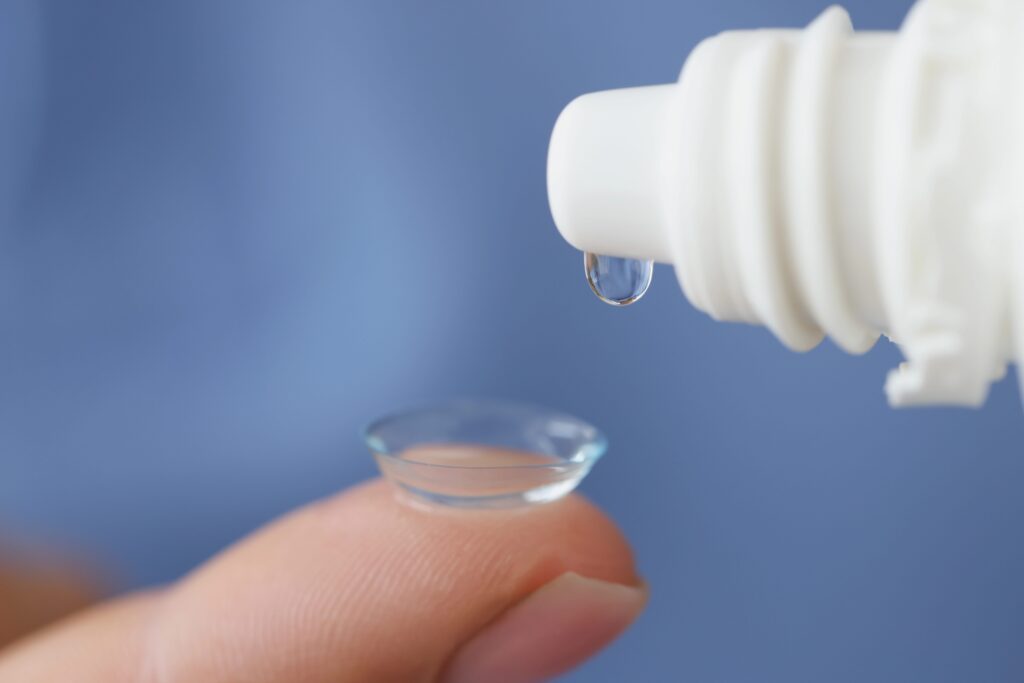Wearing contact lenses can be a convenient way to correct your vision, but unfortunately, it sometimes comes with an unwelcome side effect: dry eyes. If you’ve ever experienced stinging, irritation, or a gritty sensation while wearing contacts, you’re not alone. Many contact lens wearers experience dry eye symptoms. For some people, the contacts are the reason for the dryness. For others, dry eyes are a part of their daily life, and contacts exacerbate their symptoms. Whether your symptoms are mildly annoying or seriously uncomfortable, it’s important to talk to your eye doctor about the connection between dry eyes and contacts. They can help you find relief.

The Connection Between Dry Eyes and Contacts
Did you know that contact lenses can interfere with the natural moisture balance of your eyes? Normally, your tear film keeps the surface of your eyes well-lubricated and comfortable. But when you wear contacts — especially for long periods — they sit directly on the eye’s surface and can reduce oxygen flow and disrupt tear distribution. This can cause your tears to evaporate more quickly or become less effective at keeping your eyes hydrated. Some people may also produce fewer tears or lower-quality tears, exacerbating the problem. This can lead to frustrating dry eye symptoms, including dryness, scratchiness, irritation, and blurry vision.
So, what can you do if your contacts are causing or worsening dry eyes? Can you reduce those uncomfortable symptoms? Or is wearing glasses your only option for relief?
How to Reduce or Alleviate Dry Eye Symptoms
First, make an appointment with your eye doctor to discuss your dry eye symptoms. They may be able to prescribe a different contact lens product made from a more moisturizing material. Or, they might recommend that you switch to daily disposable lenses, which are thinner, more breathable, and less likely to accumulate deposits that could irritate dry eyes. If your dry eyes are partially caused by meibomian gland dysfunction, you may also be a good candidate for certain dry eye treatments, such as iLUX2 or Intense Pulsed Light (IPL) therapy. Finally, your eye doctor may recommend prescription or over-the-counter eye drops that you can use to keep your eyes moist and lubricated throughout the day.
Many people also find it helpful to make some small adjustments to their daily routine. For example, you may wish to try the following at-home remedies:
- Use a humidifier to add moisture to the air in dry indoor environments.
- Reduce your screen time. People blink less when staring at screens for long periods, so it’s important to take regular breaks and remind yourself to blink often. Try incorporating the 20-20-20 rule.
- Apply a warm compress to your eyes for comforting relief. Leave it on for 5 or 10 minutes, and then gently massage your eyelids to encourage the flow of oil from the meibomian glands.
- Stay hydrated by drinking plenty of water throughout the day.
- Opt for glasses more often. If your eyes are irritating you, consider switching to glasses for the day. In addition, wear your glasses in the morning and at night to limit the amount of time you’re wearing contacts.
_____
Do you suffer from dry eyes? Talk to your eye doctor about the connection between dry eyes and contacts so that you can find the best product for your symptoms and routine. In addition, discuss other treatments you can use to alleviate your symptoms, such as prescription eye drops, over-the-counter artificial tears, IPL therapy, Low-Level Light Therapy (LLLT), or iLUX2 treatments.
If you live in southwest Missouri, stop by Heffington’s. Since 1975, the Heffington family has assisted the Springfield community with top-quality eye care and affordable eyeglasses and contacts. To learn more about our products and services, please get in touch with us online, send an e-mail to asktheexperts@heffingtons.com, or give us a call at 417-869-3937 (Optiland location) or 417-882-3937 (House of Vision location).
